

Jerry Donaldson interview
By Scott Stilphen
(2018)
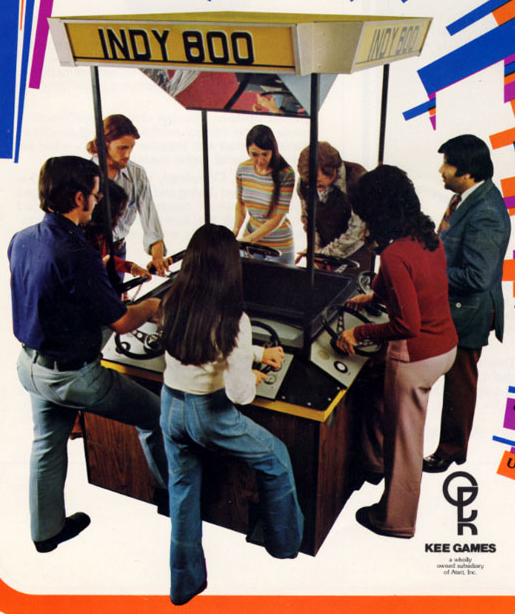
Jerry appeared on this Indy 800 flyer. He's the guy wearing the brown sweater with his head down. The man to his left
(next to the women with the red shirt) is Satish Bhutani. He retired as Vice President of Sales from Atari Games in 1988.
Jerry Donaldson was a prototype cabinet designer at Atari (under Nolan Bushnell), and one of the early unsung heroes. He was kind enough to share his memories of what it was like working for Atari in the early 1970s.
Q: What's your educational background? Was it primarily your experience from the Navy?
Jerry Donaldson: Education-wise I have had a lot of college but no degrees.
Q: Did you work anywhere prior to Atari?
Jerry Donaldson: My first job in San Jose was at Signetics Corp in 1968. It was one of the few companies making semiconductor wafers at the time.
I worked in the machine shop where we made all the equipment needed to handle, test, and package the final product. I made friends with some of the electronic engineers who were always talking about transistors and integrated circuits. It was all Greek to me because in the Navy I had learned vacuum tube theory. After a few years, with help from these engineers and several college classes, I got up to speed on electronics. Besides living in Silicon Valley, you can almost
learn electronics by osmosis.
Q: What years did you work at Atari? You mentioned starting there in 1973 and then leaving for a year and coming back, and then later were laid off.
Jerry Donaldson: I started at Atari early in 1973 and left in 1975.
Q: Did you work a particular shift or did you work whenever you wanted (flex time)?
Jerry Donaldson: I usually worked during the regular day time hours but spent many evenings and weekends there. My boss in the engineering lab was Don Lang, who pretty much let me come and go as I needed to. We would sometimes gather in Nolan Bushnell's office in the evening to talk about possible future games. That wasn't too taxing, since anything we came up with had never been done before.
Q: Do you recall what games you personally prototyped?
Jerry Donaldson: I worked on many games doing mostly mechanical things. I would pick up a game as an engineering prototype and make it into a production product. I worked on games like QWAK!, Touch Me, Gran Trak 10, Gran Trak 20, Cocktail Pong, etc. On Gran Trak 10 and Gran Trak 20, I did all the cabinet work. On some of the others, I did some cabinet development or wire harnesses or maybe just some production support. I'm in the fire suit on the game's advertising flyer.
I spent several months building arcades away from the Los Gatos plant, but I was still working for Atari during that time. When that was done, I went back to the Los Gatos plant and got caught in the crossfire between Atari and Kee Games management. Anyway, I was anxious to get back into the electronics end of things. After all, this was Silicon Valley.
I learned programming as an applications engineer for Teradyne Corp and wrote code for most of the next 30 years.
Q: Did you build/design the Atari "theatre kiosks", store kiosks, or any non-arcade cabinets?
Jerry Donaldson: I don't recognize any of the cabinets in the photos, and they aren't similar to the kind we made.
Q: Any final thoughts on your experiences at Atari?
Jerry Donaldson: Atari in those days was one fun, exciting place, and with people like Nolan Bushnell, Steve Jobs and Ron Wayne around, it was always a highly-charged atmosphere. Everything we were doing was new, and there was a lot of "make it up as you go". I couldn't wait to go to work every day, and that time is one of my best memories.
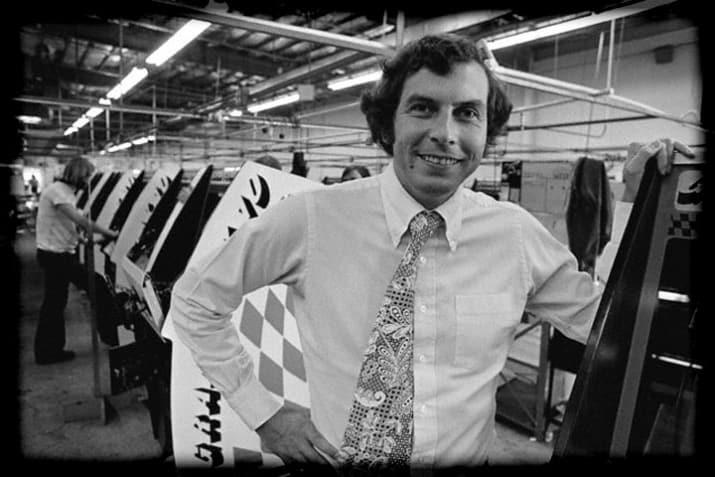
Nolan Bushnell on Atari's arcade production floor while Gran Trak 10s are being built.
Jerry posted the following on the Atari.IO forum, which is an excellent summary on his time at Atari:
HIRED AT ATARI
Here's how I got hired.
In 1973 I found an ad in the San Jose Mercury New want ad section for a production job at Atari. I didn't know what they did, but the ad mentioned soldering and wiring and I had electronics training in the Navy. I went to the factory in Los Gatos and got an interview right away. The lady doing the interview said that before we got too far along, she wanted to show me the production floor to see if I could work in that environment. On the way, I saw my first Pong
game in the hallway. It had just gone out of production.
As we toured the plant, I could see why some people might not feel comfortable working here. At the time, I was 30 and most of the workers were much younger than me and many were dressed like hippies. They were making Gotcha. At one end of the production floor, there was a large sign that read SUB ASS - short for sub assembly. On the other end, there was a moving assembly line for final assembly. It all looked exciting to me.
Back in her office, she asked me a lot of questions and at one point said, "I think I'm going to have you talk to our VP of Engineering, Al Alcorn." His office was down at the far end of the building, right outside the engineering lab. He was an imposing figure who I instantly realized was very sure of himself and very into his job. He saw on my resume that I had worked at a small start-up company; there were a lot of them in those days, so he was very proud to tell me
how he was Atari's first engineer when it was just a start-up. We had something in common. We talked start-ups for a while, and then he drew some circuits on his blackboard (yes, it was a blackboard, not a whiteboard). I stumbled my way through that, he showed me around the lab, and offered me a job. I started the next day.
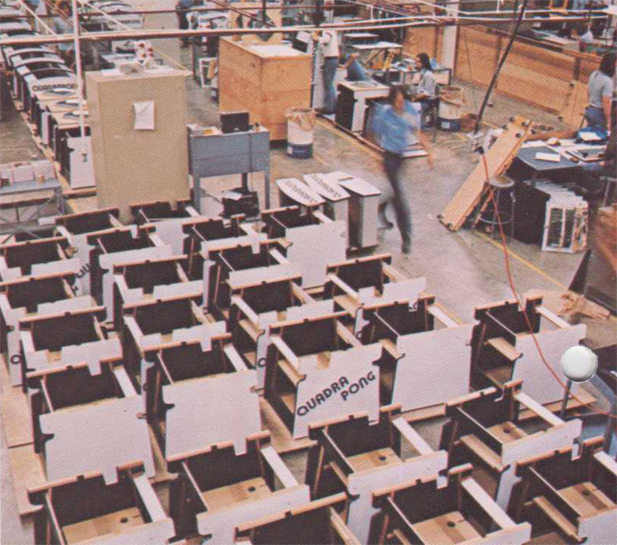
Atari's arcade production floor showing Quadrapongs being built.
FINDING MY FUNCTION AT ATARI
My boss in the lab was Don Lang, and the first thing he did was put a small, aluminum box on my desk and said, "See what you can do with this". It was about 4 X 4 X 2 inches, had an on/off switch on the side, and a panel on the top with 4 LEDs and 4 buttons. It was the first prototype for the Touch Me game, the forerunner of Milton Bradley's hand-held, Simon. I played it all day. It wasn't a very successful game, but we had an arcade-size prototype in the
lab and we would play it as a 4-player game. Each player was assigned to a button and as the game progressed, everyone would forget when it was their time to press their button. It was hilarious.
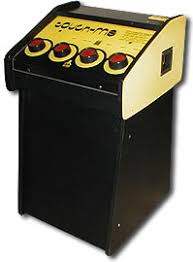
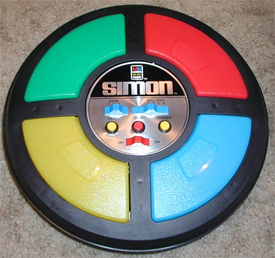
(LEFT) Atari's 1974 Touch-Me arcade game; (RIGHT) Milton Bradley's 1978 Simon hand-held.
Later that week, I attended an in-house class that taught all new engineers the circuitry used in Pong, concentrating on the composite sync signal. I think the instructor's name was Mac. I had a basic understanding of electronics, including integrated circuits and transistors, but much of this was new to me. On the wall in the classroom was a clock that was upside-down - the face was a mirror image and it ran backwards. I thought, "Welcome to Atari", which was
starting out to be different than any other place I had ever worked.
After the class, I was pretty much left alone to figure out where I could best contribute to the success of this amazing company.
The production floor at Atari was similar to most. It was a large, open area, with a flow solder machine and pc board assembly on one end and final assembly for the cabinets on the other end; there were probably about 100 people working in that area. During break time, the final assembly workers played foosball on a machine set up in their area. On the final assembly end of the building there was a model shop run by a guy named Holly. He had 5 or 6 young men
working for him making parts for the game currently in production. In the shop there was a lathe, milling machine, router, thermal forming machine, table saw, etc. Most of this equipment was very familiar to me because I had been a machinist at one time. Holly and I struck up an instant friendship, and I had the run of the shop. There was a large fish tank in the lobby made of inch-thick Plexiglas. I later learned that it was made in this shop.
With all this equipment available to me, I convinced my boss that I could build the cabinet, mount the TV, make the wire harness, install the coin handling, and basically make the first complete prototype for any new game. I would just need help with the graphics on the cabinet because I have no art gene. This became my function, but it didn't make our mechanical designers or draftsmen very happy because when I completed a prototype game, I
would put it next to their drawing board and have them measure what I made and make drawings. There was no thinking or creativity left for them to do.
NOLAN BUSHNELL
Nolan Bushnell was about 30 at the time and a fun, interesting, charismatic guy - the kind of person who, when he walked into a room, everyone would stop and look in his direction. He would often ride his bike to work and enter the plant back by the loading doors. Then he would wheel his bike all the way through the assembly area to his office.
My wife, kids, and I were at a restaurant in San Jose one Saturday morning when Nolan walked in. We invited him over and he ate breakfast with us. He knew my kids because I often brought them with me when I went into work on weekends. My kids were quite young, maybe 4 or 5, when they first started to come with me. I would put a chair in front of the games for
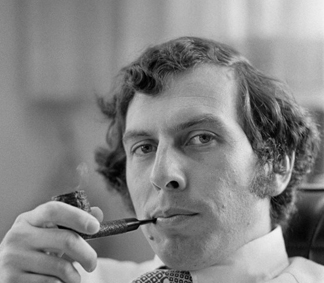 them to stand on and show them how to trip the coin acceptor switch to start the game. They had the run of the building and must have thought it was a magical place.
them to stand on and show them how to trip the coin acceptor switch to start the game. They had the run of the building and must have thought it was a magical place.
One summer the air conditioning went out and it couldn't be fixed for some time. Nolan Bushnell came out to the production floor with his bullhorn and announced that we would leave the large, loading doors open, install some fans, and that everyone could wear whatever they wanted. The only exception was the people who were soldering had to have a towel on their lap. The next day, all the young girls wore bikinis. The air conditioner was fixed in record time, much to the
dismay of many of the young guys.
I see there is a picture of Nolan with his pipe tagged on the end of one of administrator Justin's posts. We remodeled Nolan's office one time and put a large vent over his desk for all the pipe smoke. I can still smell it now.
At one point we expanded Nolan's office, and when I was finished with a game prototype, I would put it the expanded part, so I spent a lot of time in his office. After a while, it looked like his private arcade. He liked it because he had managed an arcade while he was in college. He wanted to teach me the Japanese game of Go, but we never got around to it.
When I was in there one day, I told him I was trying to buy my first house. He immediately said, "I can't give you any money, but I can give you a raise. You will have to transfer to my department and get your paychecks from accounts payable." This was fine with me and actually nothing really changed as far as me working in the lab and reporting to my boss, Don. Being in the same department as Nolan would eventually prove to be a big problem for me.
On Halloween, Nolan would wear a pig costume and walk around in it all day. It was a pink suit, kind of like the one Ralphie got for Christmas in the movie, "A Christmas Story". Nolan's also had a plastic pig head. One year for his birthday we wanted to get him a large, stuffed animal that looked like a pig but could only find one that looked a little bit like Mickey Mouse. It was almost 4 feet tall and stood up. Nolan liked
it and named him Chuck. He put it in the hall right outside his office door. Sometime later, Nolan told me he was going to start a new venture (not with video games) and wanted me to be part of it. I said, "I'm in" and that was the last I heard about it. He would go off sailing for months at a time; he actually won some races to Hawaii. I eventually left Atari. I walked into a restaurant a few years later and saw Nolan and Joe Keenan at a table. I
sat with them and Nolan said, "You could have been part of this." – ‘this’ being "Chuck E. Cheese".
Over the years, I would run into him at electronic shows and other events, and he was always the same, bigger-than-life guy. When I retired many years later, I called him up and we had a nice, long talk about "the old days". I forgot to ask him if he still had Chuck.
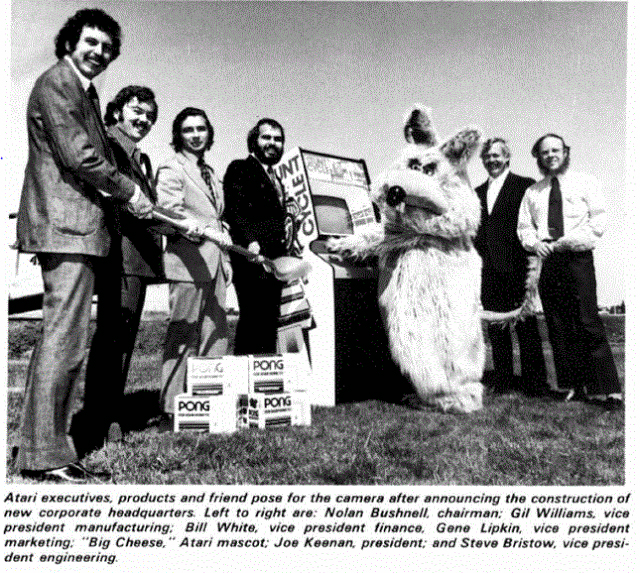
CASTLE BUILDING AT ATARI
There was kind of a celebration in the lab one day when Nolan came in and told us that he had been awarded a patent for a Video Image Positioning Control System for an Amusement Device. He said, "This makes Atari the official originator of the video game." The only video games being made in those days were the large arcade-type, and Atari sometimes shipped up to 100 a day. Every single one contained a TV. There were no monitors then so we might receive 100 televisions
every day. We had a department called TV MOD where the picture tube and its chassis were removed from the plastic case, which was thrown in a large dumpster. We eventually got a crusher to compress the plastic cases. The chassis was then modified to accept the composite sync signal. TV MOD was just one guy who wore his complete band uniform - including high hat and shoulder Epaulettes - to work every day. He had an area against one wall about 15x30 feet, and began
to surround himself with gray, metal shelves. After he had put shelves all around his area, he covered the back of them with the cardboard from the TV boxes. When that was done, he used a black felt-tip marker to draw brick shapes on all the cardboard. He had left an opening to get in and out and even that had cardboard doors with a cardboard spire on the top. The whole thing looked just like a castle. We eventually had to take it all down because we suspected there
were some dealings going on in the castle.
We had a bomb scare one time where we all filed out into the parking lot. While the building was being searched, there were a lot of parties going on in Volkswagen buses. Nothing was ever found, but there were rumors that it was an excuse for NARCS to conduct a search; it was the 70's in California.
STEVE JOBS COMES TO ATARI
One time Al Alcorn came into the lab and introduced a new engineer dressed in a toga and sandals named Steve Jobs. He must have been about 19. Like me, he didn't seem to have a specific job for the first few weeks and just hung around the lab. He then started working on Breakout. Sometimes he would take his pad and go down to the local park for hours. I think he came out to lunch with us a few times, but he
wasn't very social. His bench was right next to mine, but he was different and a tough person to get to know and get along with.
Nolan Bushnell would often talk to us about his plan to get video games into people's homes using their televisions, which eventually happened with the VCS. This could have sparked some of Steve's ideas. I know he asked Nolan to back him financially with his plan to start a company and build a computer, but Nolan wasn't interested.
I went to see Steve years later when he was trying to get his Next computer up and going. As soon as I walked in he said, "I don't have any jobs available." I told him I wasn't looking for a job and started to talk about the old days at Atari, but he just wanted to talk about what he was into now and where he thought it was going. He was always marketing his new ideas. Many years later, I was working for a company that was supplying some test equipment to Apple and I was
loaned out to them for over a year. I worked in Apple's Milpitas building. I ran into Steve a couple of times, but we didn't have much in common. I was working there during the big earthquake that stopped the World Series in 1989. It was an "earthquake proof" building, so is rocked and rolled the whole time with almost no damage.
Steve ultimately proved to be one of the best marketers ever. I'm glad to have known him.
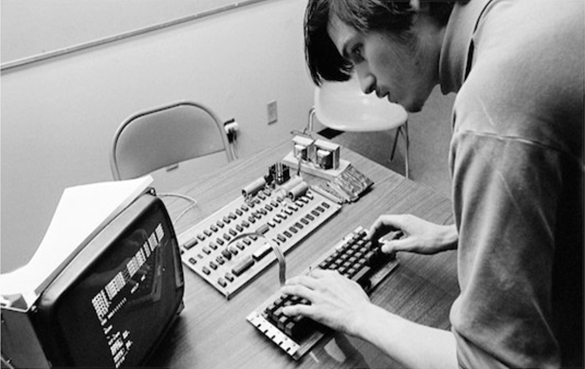
Steve Jobs with an original Apple computer. Note the similarity of the motherboard's design to Atari's arcade pcbs at the time.
RON WAYNE, APPLE FOUNDER, COMES TO ATARI
You probably know that Ron Wayne was a founding member of Apple Computer. In fact, if you look him up on the Internet, he is called "The Fifth Beatle of Apple". He and Steve Jobs worked together in Atari engineering lab. If you want to know his story, you should get his book, Adventures of an Apple Founder.
One day Al Alcorn came into the lab and showed us a resume he had received. It was from a man who designed pinball and slot machines. We all kind of snickered, but Al said, "I'm going to hire him because he will have a different outlook about games."
A couple of weeks later, Ron Wayne showed up in his signature sport coat, short-sleeved white shirt, tie, and slightly gray crew hair cut. He was probably about 40 at the time. Being the "older guys", he and I struck up a friendship. He asked me what I did and when I told him I make the prototype games, he suggested that we work as a team where he would make the drawings and I would make the parts. I agreed. For a new game, we would start with about 10 possible
shapes for the side panels of the arcade cabinet, drawn by our art department. We would then would have a meeting, which Nolan Bushnell attended, and try to pick one. This is where I learned that deciding things by committee didn't work. We could get it down to 2 or 3 and Nolan would pick one and that was it - meeting over. Ron would go to work on his drafting board, and after a few days start feeding me drawings for parts to make in the model shop. Ron eventually
took on the task of selecting the shape of the cabinet sides. One time when I was trying to assemble a game cabinet, there was an interference problem. I showed it to Ron and he said, "It just proves the physics principal that no two solid objects can occupy the same space at the same time." His comment rekindled my interested in physics, which is still alive today. After that, I often bugged him for more "pearls of wisdom" about physics.
A game that Ron and I worked on together was Gran Trak 10 - the first video driving game. Due to some electronic design problems and miscalculation of the cost of manufacturing, it was not one of Atari's instant financial winners, although it eventually became a huge success. Later, I think I made the cabinet for Gran Trak 20, which was a 2-player version. When the prototype of Gran Trak 10 was done, we spent a few days checking it out and then I put it in my
station wagon on a Friday afternoon and took it to Rooster T. Feathers; it's a sports bar on El Camino Real in San Jose. I think it's still there. Atari had a deal with them where we could put a game in there for a few days and split the take. Al Alcorn had done a similar thing at Andy Capp's Tavern with one of the early Pong games, and got a call late at night complaining that it was broken. When he got there, he saw that the coin box was overflowing and the quarters had
jammed the coin acceptor, and he knew they had a winner. I came back later that evening and there was a line of people waiting to play Gran Trak 10. I got in line, and when I started to play, a lot of people gathered around to watch me use the gas pedal, shift lever, brake and steering to skid around the corners; I had been playing it for weeks. I emptied the coin box before I left, came back twice on Saturday to empty it again, and picked it up on Sunday. The management
wasn't too happy to see it go. The game shown in the advertising flyer for Gran Trak 10 on Wikipedia is the original prototype designed by Ron Wayne, built by me in the model shop, and taken to Rooster T. Feathers. It ended up in Bushnell's office.
Ron eventually became a very important part of the Atari team. Besides being a design engineer, he invented and implemented a complete part numbering and stocking system, moved into Marketing, traveled all over the world qualifying video game distributors, and was tasked with preparing an analysis of what it would take to produce a new generation of pinball machines. Ron and I have recently reconnected after 40+ years and are working on a project together. It has nothing to do
with video games, slot machines, or pinball machines.
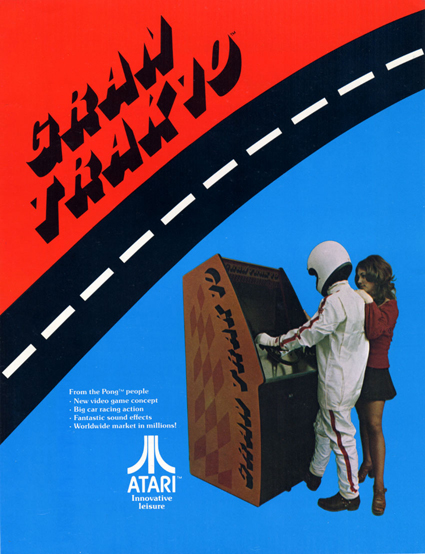
Atari's Gran Trak 10 flyer, with Jerry and Karen (last name unknown), one of Atari's secretaries.
QWAK QWAK
One of the games I worked on was Qwak!. It was a duck-shooting game and I don't recall if I made the original cabinet, but Al Alcorn called me into his office one day to talk about the gun used to shoot the ducks. He had found a source for the rifle stocks in Mexico and, knowing I had once been a machinist, asked me to fly down there to check it out to see if they could supply up to 100 per day. I had never done anything like this before, but it was Al Alcorn asking, so
I boarded a plane at the San Jose airport a couple days later, carrying a rifle stock wrapped in brown paper. I had to change planes in LAX for a plane to Lindbergh field in San Diego. 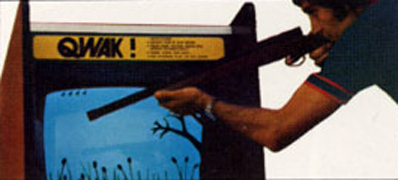 When I put the stock
through the X-ray machine, the operator motioned to a guard who came over, and with gun drawn, ordered me "up against the wall". Apparently they didn't like me bringing a gun onto their plane. I explained what it was, what I was doing, and showed them my Atari badge. They unwrapped the stock, inspected it for several minutes, and sent me on my way.
When I put the stock
through the X-ray machine, the operator motioned to a guard who came over, and with gun drawn, ordered me "up against the wall". Apparently they didn't like me bringing a gun onto their plane. I explained what it was, what I was doing, and showed them my Atari badge. They unwrapped the stock, inspected it for several minutes, and sent me on my way.
From San Diego, I drove a rental car across the border to the wood shop, which wasn't much more than a barn with a dirt floor. There were 10-12 tracer lathes all running and all producing the same part. There were boxes and boxes of finished parts stacked around the barn. The man who owned the shop spoke perfect English. He took the stock I had, set it up in one of the tracer lathes, and made one in a few minutes. I knew they could supply all we needed. I left
the stock there not wanting to get put "up against the wall" on the way back.
After that, the gun became my project. All the electrical engineering had been done, but I worked on the cable harness, holster, and a method of securing it to the cabinet so it wouldn't get stolen. When that was done, I got the game ready for production. Qwak! only sold about 250 units, even though it was a good game. When a duck was shot out of the air, it spun down to the bottom of the screen and a dog would run along the bottom, grab the dead duck, and drag it off the
screen. I heard one time that the biggest complaint was that the player couldn't shoot the dog.
LLOYD WARMAN BECOMES VP OF ENGINEERING AT ATARI
There came a time when Al Alcorn had other things he wanted to do at Atari, so he hired Lloyd Warman to take his place as the VP of Engineering. Lloyd had been an EE at Ampex, so he would often become involved in hardware design and debug. When we were making some version of cocktail Pong, there was an assembly problem on the production floor. I happened to be standing near him when he heard about it and he asked me to go with him to look at the problem. There was
some part that wasn't mounted good enough. Someone suggested that we glue it and I said that was a bad idea because glue will get all over, and it's never a good idea to use glue in a production environment. I volunteered to design a bracket to fix it. On the way back to the lab, Lloyd said, "You will be my troubleshooter." He and I got along very well both at work and socially. We would go out to dinner and visit each others houses. I got to know his wife and
kids, and he got to know mine.
It was typical that a game company would only qualify one distributor in each city, but crafty Nolan Bushnell set up a separate game company called Kee Games that seemingly had no connection to Atari. It was run by Joe Keenan, who was a neighbor of Nolan’s. The "unqualified" distributors were more than happy to buy games from Kee thinking they were "sticking it" to Atari. One day, someone showed me an article in the paper that revealed the fact that Kee Games was actually a
wholly-owned subsidiary of Atari, so there was no reason to keep the two companies separate after that. Kee Games was shut down and many of their managers and engineers came to Atari. After a heated meeting one day with managers from both Atari and Kee Games, Lloyd told me someone from Kee Games fired one of Atari's managers. Lloyd had attempted to defend the fired manager, but the same person from Kee turned to him and said, "You're fired, too"! Lloyd went to Nolan
Bushnell later that day and complained that there was no reason for him to have been fired. Nolan agreed and said he had a side project that Lloyd could do until he found a new job.
BUILDING ARCADES AND MOVING ON FROM ATARI
A side project given to Lloyd Warman was building some arcades to be installed in shopping centers around northern Cal. These were probably part of the Atari Leisure-Time Game Center. Lloyd asked me if I wanted to help with this project; I accepted and recruited a couple of the best workers from the model shop. We rented a large, empty warehouse on Scott Blvd and got together all the tools we needed. The sequence was, we would get the address of the rented space and go
there and take very accurate measurements of its dimensions. Back at the warehouse, we would use tape to lay out the exact floor dimensions and build the arcade. It would consist of many Atari games but in custom made cabinets. We had the services of Atari's art department and also full access to Atari's parts department. We built all the custom cabinets right in the warehouse and had custom fiber glass bezels made at a local shop. These cabinets didn't look
anything like the games that were shipped from Atari, but the electronics inside were the same. We had to make our own front panels and wire harnesses and then assemble everything, but we were all old hands at this. We even added some pinball machines to the mix. We made all the decorations for the arcades and in one, we put 4x8 sheets of mirrored Plexiglas on the ceiling. For another, we built a kiosk for a four-player driving game. Somehow LLoyd was able to get
the electronics, which had been developed at Kee Games. We built a small arcade in a few weeks, but the larger ones took months. When we finished one, we would rent trucks, disassemble everything, load it all into the trucks, drive to the space, and then re-assemble and install everything. When we got it all done and working, we just locked up the arcade and left. Over a several month period, we build and installed several arcades.
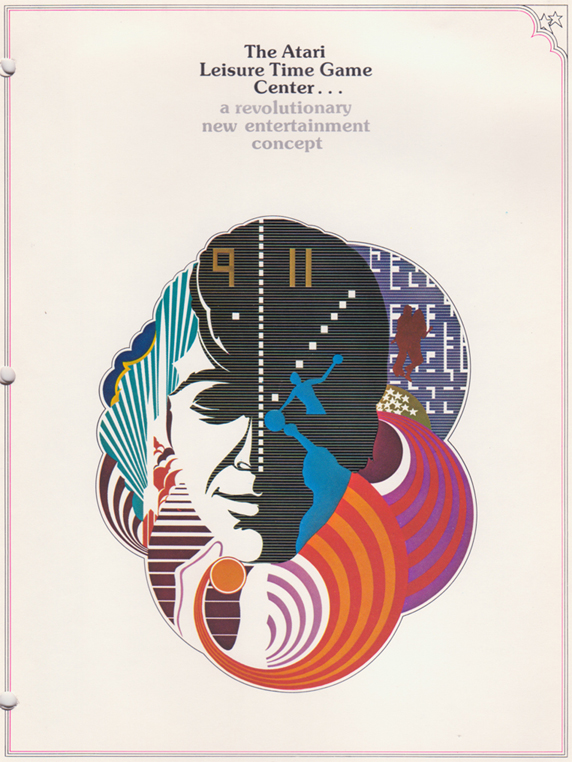
Click on the photo to download the full brochure.
About half-way through building the last one, Lloyd asked if he could come to my house that night to talk about future ventures. He arrived around 7pm, and we sat and talked at my dining room table long enough to consume an entire bottle of Tia Maria and a small bottle of gin. I'm pretty sure he stayed the night in my spare bedroom. He asked me all kinds of questions about my education, past jobs and we even talked politics. He must have heard what he wanted because he
eventually told me he was moving back to Vancouver, Canada, where his mother still lived, to start a new company possibly making video games, and he wanted me to come with him. I couldn't answer just then because I had to talk to my wife, who had long since retired for the night. When I got up in the morning, Lloyd was already gone. I told my wife about his proposal and she was all for it, so we talked to a realtor about selling our house and started the processes of getting
passports and applying for immigration. Several weeks later, Lloyd and I flew up to Vancouver and stayed at his mother's house. We spent a few days driving around the area with no real goal in mind. By the time we flew back to California, I realized that he didn't have any concrete plans for starting up a company, so I backed out. When we finished the last arcade, we closed down the warehouse, and me and the guys I had recruited from the model shop went back to Atari.
Lloyd moved to Canada.
I had been gone from Atari for most of a year and lots of changes had taken place. Since all of Kee Games had been integrated into Atari, production was moved to the building on Martin Ave in Santa Clara. I went over there to see what was going on, and as I was walking around, I saw Nolan in the hall and he asked me, "How do you like your new digs?" I wouldn't be there for long. The next day, I went back to the Los Gatos building to see if they needed me there.
Steve Bristow, who I knew quite well, was now the VP of Engineering and there was most of a new crew in the lab. Many of the people I had known had gotten caught in the crossfire between Atari and Kee Games and the place just didn't feel the same. Steve offered me a position where I would do a final inspection of the prototype games made in the engineering lab and maybe I could do something in the model shop. I got the feeling that he didn't want me actually working in the
lab. I told him I would look around for something else to do. On the way out, I saw an org chart on a board in someone's office, and of course Nolan's name was in the box at the very top, and there was a line going off to the right to another box with my name in it above everyone else. Nolan had transferred me to his "department" a couple years earlier. I immediately knew this was going to be a BIG problem. I went back to the building on Martin Ave and just wandered
around and helped out for a couple of weeks when Steve Bristow came by and said they really couldn't find a place for me. I knew that meant that I was now in the crossfire, and that was my last day at Atari.
It had been an exciting time working in a virgin industry with people like Nolan Bushnell, Steve Jobs, and Ron Wayne, and my time there is still one of my favorite memories, but it was time to move on. Of course in the long run, as is often the case, it was the best thing that could have happened. Atari had moved on from me, and I was anxious to get back into the electronics end of things. After all, this was Silicon Valley. It was a pleasure to share my stories, and I
hope they provided some insight to the early days of this unique company.